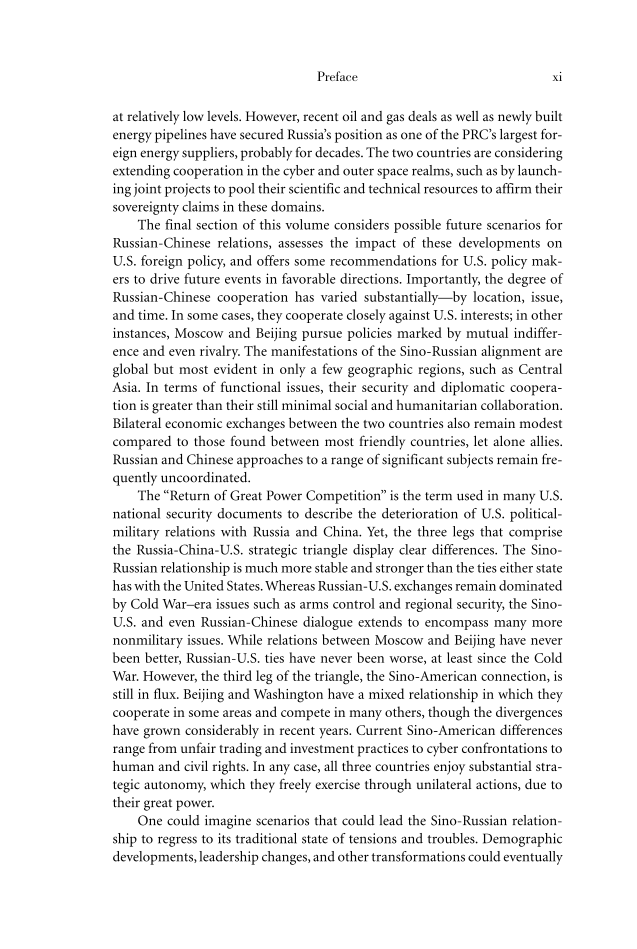Preface xi at relatively low levels. However, recent oil and gas deals as well as newly built energy pipelines have secured Russia’s position as one of the PRC’s largest for- eign energy suppliers, probably for decades. The two countries are considering extending cooperation in the cyber and outer space realms, such as by launch- ing joint projects to pool their scientific and technical resources to affirm their sovereignty claims in these domains. The final section of this volume considers possible future scenarios for Russian-Chinese relations, assesses the impact of these developments on U.S. foreign policy, and offers some recommendations for U.S. policy mak- ers to drive future events in favorable directions. Importantly, the degree of Russian-Chinese cooperation has varied substantially—by location, issue, and time. In some cases, they cooperate closely against U.S. interests in other instances, Moscow and Beijing pursue policies marked by mutual indiffer- ence and even rivalry. The manifestations of the Sino-Russian alignment are global but most evident in only a few geographic regions, such as Central Asia. In terms of functional issues, their security and diplomatic coopera- tion is greater than their still minimal social and humanitarian collaboration. Bilateral economic exchanges between the two countries also remain modest compared to those found between most friendly countries, let alone allies. Russian and Chinese approaches to a range of significant subjects remain fre- quently uncoordinated. The “Return of Great Power Competition” is the term used in many U.S. national security documents to describe the deterioration of U.S. political- military relations with Russia and China. Yet, the three legs that comprise the Russia-China-U.S. strategic triangle display clear differences. The Sino- Russian relationship is much more stable and stronger than the ties either state has with the United States. Whereas Russian-U.S. exchanges remain dominated by Cold War–era issues such as arms control and regional security, the Sino- U.S. and even Russian-Chinese dialogue extends to encompass many more nonmilitary issues. While relations between Moscow and Beijing have never been better, Russian-U.S. ties have never been worse, at least since the Cold War. However, the third leg of the triangle, the Sino-American connection, is still in flux. Beijing and Washington have a mixed relationship in which they cooperate in some areas and compete in many others, though the divergences have grown considerably in recent years. Current Sino-American differences range from unfair trading and investment practices to cyber confrontations to human and civil rights. In any case, all three countries enjoy substantial stra- tegic autonomy, which they freely exercise through unilateral actions, due to their great power. One could imagine scenarios that could lead the Sino-Russian relation- ship to regress to its traditional state of tensions and troubles. Demographic developments, leadership changes, and other transformations could eventually
Document Details My Account Print multiple pages
Print
You have printed 0 times in the last 24 hours.
Your print count will reset on at .
You may print 0 more time(s) before then.
You may print a maximum of 0 pages at a time.

























































































































































































































































































